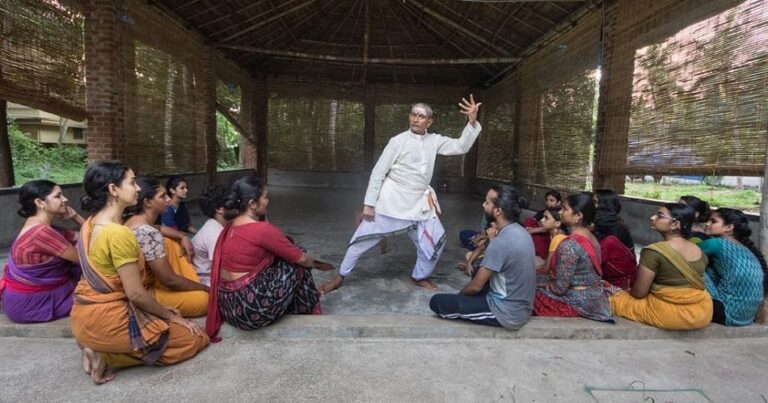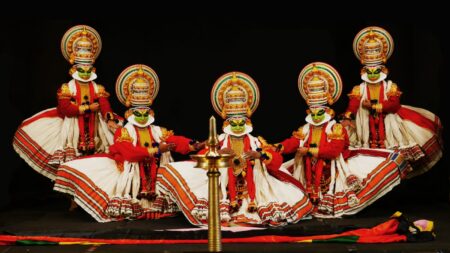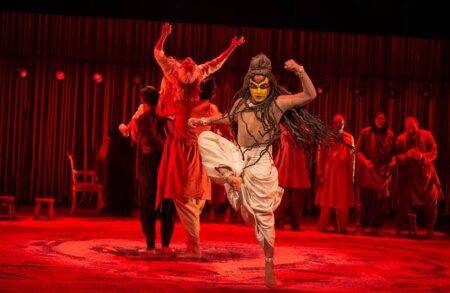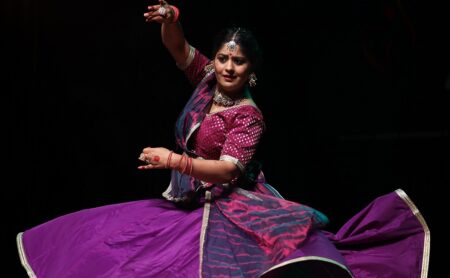On international dance day, (April 29), guru Pasumarthi Rathiah Sharma talks about traditional Kuchipudi and its evolutionary journey.
It was a sunny afternoon at Trichur, Kerala, when I met Pasumarthi Rathiah Sharma, the veteran artist of Kuchipudi Yakshagana. He was on a visit to Kerala for leading a workshop organized by his favourite disciple and renowned dancer Sreelakshmi Govardhanan. I had heard about this ardent follower of the old “Bani” in Kuchipudi years ago from Sreelakshmi. I was really fascinated by the strict discipline which he is maintaining in preserving the old Yakshagana tradition and decided to meet the pious looking old man.
We started talking informally with the help of Sreelakshmi, because Sharma didn’t know any other language except Telugu. But, his facial expressions while talking about the acting styles and literature were sufficient for effective communication. Actually, it was not me who began the conversation. He asked me very frankly, “Have you ever seen Kuchipudi before ?”. I said “Yes”. Soon came the next question “Who’s performance?”. Again I answered without any hesitation. “In the beginning, I used to watch Vyjayanthi Kashi, Pratheeksha, but, now for the last few years, I am getting a few chances to watch Sreelakshmi’s performances. His next question was quite obvious. “Have you found any differences between the two?” I said, ”Yes, a lot. ” Only then he accepted me to ask about him and Kuchippudi.
Gurukula training
Rathiah Sharma was born in 1940 in a typical traditional Telugu Brahmin family in Kuchipudi village of Krishna district in Andhra Pradesh. His father was Pasumarthi Viswanatham and his mother Balatripura Sundari. Like any other boy in his village, Sharma too started learning Sanskrit as part of his formal education at the age of seven. This was his entry to the strict, authentic training of Kuchipudi Yakshagana dance. His father was his first Guru. After a few years he started training under his uncle Vedantham Sathya Narayana Sharma, a renowned performer and teacher.
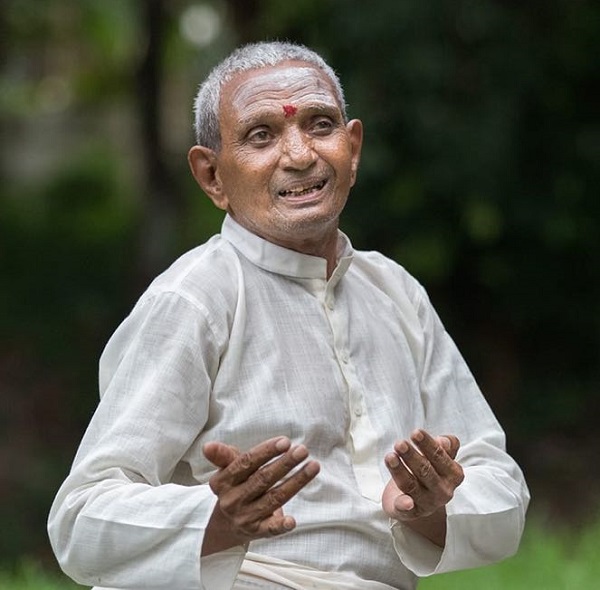
The training was very much like the ‘Gurukula’ style where the student lived with the master and learned not only the art but the social life also. During this period, Sharma read many puranic books and epics like Mahabharatha and Ramayana. This systematic training gave him a strong foundation in puranic knowledge which was essential for a stage performer. The twelve years of Gurukula which he had undergone under these two masters, really moulded the young Sharma as a performer.
“During the training time, we all students should participate in the performances. We will get some small roles in the night-long play. Along with that, we have to assist our teachers for their performance too”, Sharma added. It was not merely a dance programme which will last for one and half hours like these days. Kuchipudi Yakshagana was a full night long drama performance at that time. Normally, each performance will last for seven to eight hours.
Kuchipudi Yakshagana
“It is narration… storytelling…”, Sharma described how the Yakshagana system got ruined and the new format developed. These days, Kuchipudi is more like ‘Katcheri’ style. This was developed only fifty years ago. Before that this dance part was an element of the total drama and performance. Male artists were the dancers at that time. An artist must be trained and practice all the sections of the art form including costuming too.
He looked a little emotional and dull while talking about the change that happened in the performance style of Kuchipudi. “Nowadays nobody, not even in Andhra, is interested in our old tradition. Only some people know how to perform that. I am really sad that new generation artists are not even trying to learn it”. Sharma revealed. “There are ‘Jathiswaram’ ‘Tharangam’ ‘shabdam’ and ‘Thillana’ in the old traditional style. After some years all these were combined and created ìnto a new dance format. This is what you are watching now all over the country, and people call it Kuchipudi”, he added. He was extremely happy that at least a few new aspirants like Sreelakshmi Govardhanan are coming forward now to learn and perform the old ‘Bani’. Sreelakshmi has been learning this style for the last seventeen years by travelling from Kerala to Andhra during the non-festival season, he averred.
Change with the times
Though he is a keen follower of the old ‘Bani’ of Kuchipudi, Sharma knows well how this old one became unpopular”. In the modern world, art is not only for art sake; it is a profession too. So, many of the artists shifted their focus from the old one. They can’t get money out of this; so all of them are going with the wind. In the earlier days, we all used to travel from one venue to another by walking. Sometimes we used to stay for one or two weeks in the same place where venues were nearby. This is not possible today”, he pointed out.
Rathiah Sharma’s journey with this art form is now reaching almost seven decades. Within this large span of time, he had performed in various places in various roles. At the beginning of his career, he was a specialist in female roles. But, during his youth, he performed in leading male roles and further leader of the troupe. His favourite male roles are Prahlada, Narasimha Murthi, Lava and Kusa, Narada, and Sreekrishna. The major female roles were Leelavathi, Sathyabhama, Usha and Chithralekha and Parvathi. He has also acted in various dance ballets like, Bhamakalapam, Mohini, Rukmangada, Usha Parinayam, Sasirekha Parinayam and Ramanatakam. Sangeet Natak Akademi honoured him with its prestigious award in 2006.

